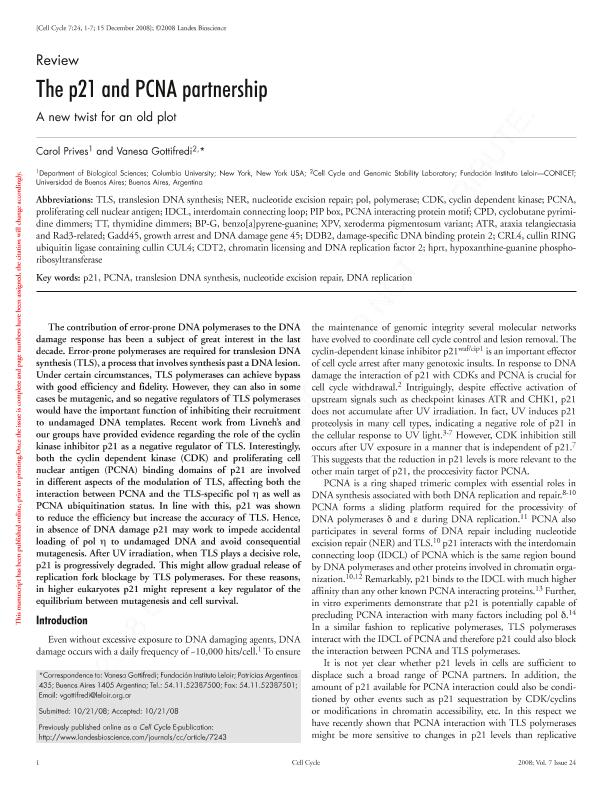Mostrar el registro sencillo del ítem
dc.contributor.author
Prives, Carol
dc.contributor.author
Gottifredi, Vanesa

dc.date.available
2017-07-21T20:00:49Z
dc.date.issued
2008-12
dc.identifier.citation
Prives, Carol; Gottifredi, Vanesa; The p21 and PCNA partnership: a new twist for an old plot; Taylor & Francis; Cell Cycle; 7; 24; 12-2008; 3840-3846
dc.identifier.issn
1538-4101
dc.identifier.uri
http://hdl.handle.net/11336/21121
dc.description.abstract
The contribution of error-prone DNA polymerases to the DNA damage response has been a subject of great interest in the last decade. Error-prone polymerases are required for translesion DNA synthesis (TLS), a process that involves synthesis past a DNA lesion. Under certain circumstances, TLS polymerases can achieve bypass with good efficiency and fidelity. However, they can also in some cases be mutagenic, and so negative regulators of TLS polymerases would have the important function of inhibiting their recruitment to undamaged DNA templates. Recent work from Livneh's and our groups have provided evidence regarding the role of the cyclin kinase inhibitor p21 as a negative regulator of TLS. Interestingly, both the cyclin dependent kinase (CDK) and proliferating cell nuclear antigen (PCNA) binding domains of p21 are involved in different aspects of the modulation of TLS, affecting both the interaction between PCNA and the TLS-specific pol eta as well as PCNA ubiquitination status. In line with this, p21 was shown to reduce the efficiency but increase the accuracy of TLS. Hence, in absence of DNA damage p21 may work to impede accidental loading of pol eta to undamaged DNA and avoid consequential mutagenesis. After UV irradiation, when TLS plays a decisive role, p21 is progressively degraded. This might allow gradual release of replication fork blockage by TLS polymerases. For these reasons, in higher eukaryotes p21 might represent a key regulator of the equilibrium between mutagenesis and cell survival.
dc.format
application/pdf
dc.language.iso
eng
dc.publisher
Taylor & Francis

dc.rights
info:eu-repo/semantics/openAccess
dc.rights.uri
https://creativecommons.org/licenses/by-nc-sa/2.5/ar/
dc.subject
P21
dc.subject
Pcna
dc.subject
Translesion Dna Synthesis
dc.subject
Dna Repair
dc.subject.classification
Biología Celular, Microbiología

dc.subject.classification
Ciencias Biológicas

dc.subject.classification
CIENCIAS NATURALES Y EXACTAS

dc.title
The p21 and PCNA partnership: a new twist for an old plot
dc.type
info:eu-repo/semantics/article
dc.type
info:ar-repo/semantics/artículo
dc.type
info:eu-repo/semantics/publishedVersion
dc.date.updated
2017-07-18T14:50:30Z
dc.identifier.eissn
1551-4005
dc.journal.volume
7
dc.journal.number
24
dc.journal.pagination
3840-3846
dc.journal.pais
Estados Unidos

dc.journal.ciudad
Philadelphia
dc.description.fil
Fil: Prives, Carol. Columbia University; Estados Unidos
dc.description.fil
Fil: Gottifredi, Vanesa. Consejo Nacional de Investigaciones Científicas y Técnicas. Oficina de Coordinación Administrativa Parque Centenario. Instituto de Investigaciones Bioquímicas de Buenos Aires. Fundación Instituto Leloir. Instituto de Investigaciones Bioquímicas de Buenos Aires; Argentina
dc.journal.title
Cell Cycle

dc.relation.alternativeid
info:eu-repo/semantics/altIdentifier/url/http://www.tandfonline.com/doi/abs/10.4161/cc.7.24.7243
dc.relation.alternativeid
info:eu-repo/semantics/altIdentifier/doi/http://dx.doi.org/10.4161/cc.7.24.7243
Archivos asociados
